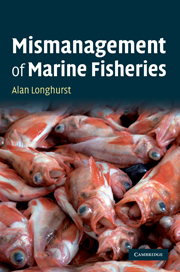Book contents
- Frontmatter
- Contents
- Preface
- 1 From certainty to doubt in fishery science
- 2 The ecological consequences of the exceptional fecundity of teleosts
- 3 Indeterminate growth, negative senescence and longevity
- 4 Marine ecosystems: their structure and simulation
- 5 The natural variability of fish populations and fisheries
- 6 Has sustainability in fishing ever been achieved?
- 7 What is the real state of global fish populations?
- 8 The mechanics of population collapse
- 9 Why don't some fish populations recover after depletion?
- 10 Is the response of the fishery science community appropriate?
- 11 Conclusion: sustainability can be achieved rarely and only under special conditions
- Index
4 - Marine ecosystems: their structure and simulation
Published online by Cambridge University Press: 05 July 2014
- Frontmatter
- Contents
- Preface
- 1 From certainty to doubt in fishery science
- 2 The ecological consequences of the exceptional fecundity of teleosts
- 3 Indeterminate growth, negative senescence and longevity
- 4 Marine ecosystems: their structure and simulation
- 5 The natural variability of fish populations and fisheries
- 6 Has sustainability in fishing ever been achieved?
- 7 What is the real state of global fish populations?
- 8 The mechanics of population collapse
- 9 Why don't some fish populations recover after depletion?
- 10 Is the response of the fishery science community appropriate?
- 11 Conclusion: sustainability can be achieved rarely and only under special conditions
- Index
Summary
‘As we know, there are known knowns . . . the things we know we know and there are known unknowns . . . the things that we know we don't know. But there are also unknown unknowns, the ones we don't know that we don't know.’
Donald Rumsfeld, 2002If we believe that marine ecosystems really can produce a surplus of biomass of some of their component vertebrates beyond what is required to sustain their natural populations, surely we should ask what distinguishes them from terrestrial ecosystems, which do not appear to have the same capacity. If the supposed surplus production of some marine vertebrates is real, and useful to us, then we need to understand what characteristics of marine ecosystems are essential for its production. We need to understand whether surplus production of fish biomass is a consequence of special characteristics of the fish themselves, such as those discussed in the previous two chapters, or of marine ecosystems in a wider sense. Discussion of these issues occupies this and the following chapter and will focus on the very different trophic structure of terrestrial and marine ecosystems, and also on the very different characteristic scales of variability of the two habitats.
At least during the formative period of fishery science, such issues appear to have been of little concern to those who had responsibility for devising – and applying – methods for fish stock management, and it has been suggested that a lack of understanding of the complexity and variability of the habitat of marine fish has been responsible for the failure of fishery science to evolve significantly from its ‘quantitative and homogeneous’ beginnings until very recently. Indeed, if agricultural scientists had as little knowledge and interest in the relationship between crop success, local geology, hydrology and soil structure as fishery scientists have had (at least in the past) concerning the habitat in which their fish swim, then modern agriculture could not have developed as it has done.
- Type
- Chapter
- Information
- Mismanagement of Marine Fisheries , pp. 56 - 78Publisher: Cambridge University PressPrint publication year: 2010



